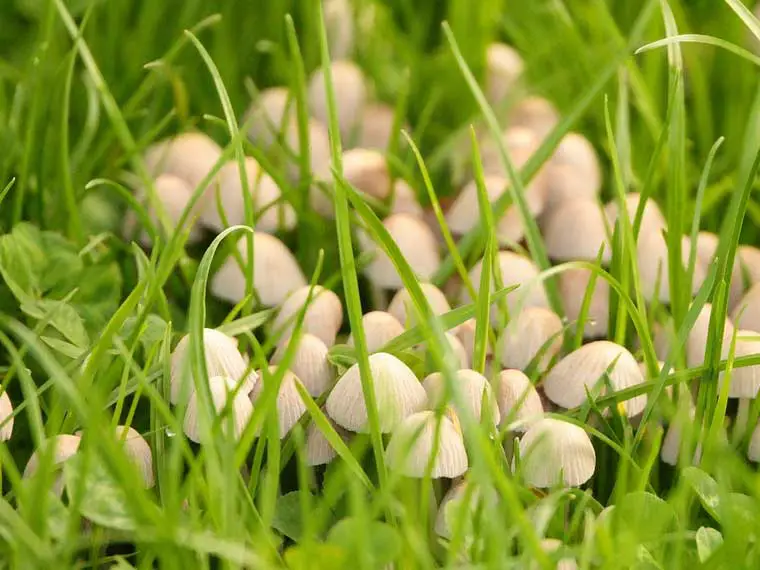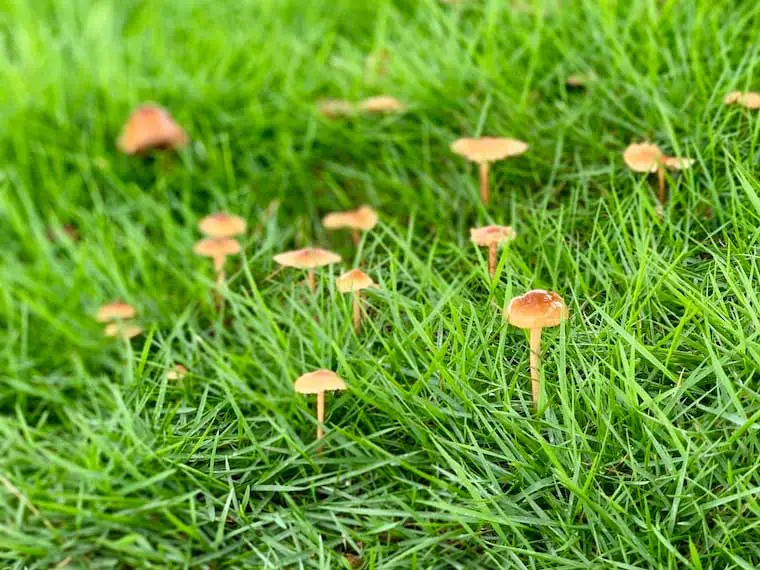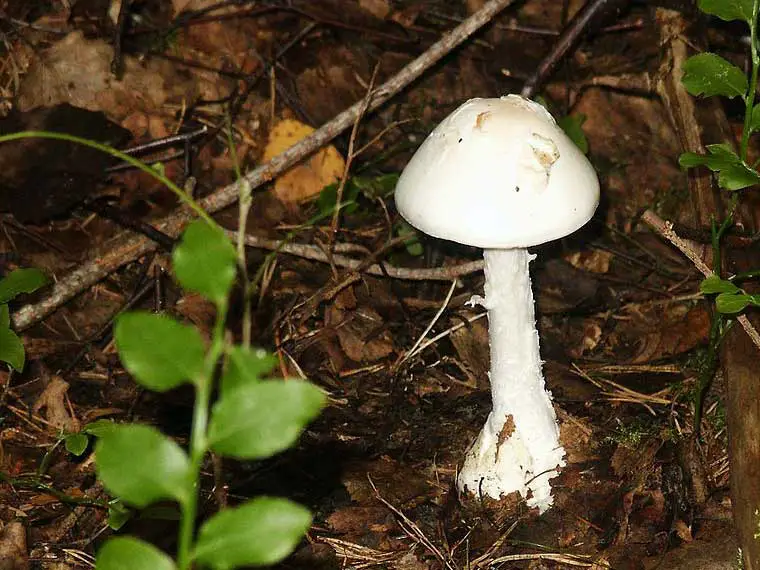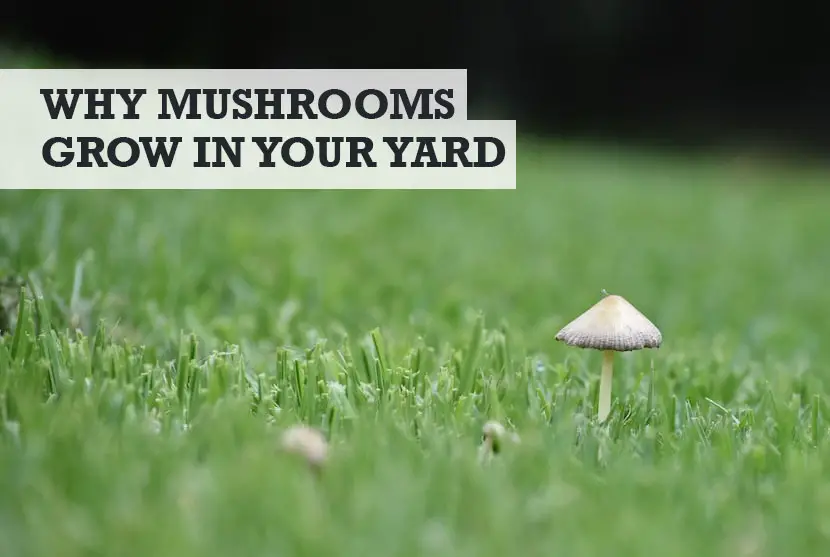You can go to bed at night with no mushrooms in your yard or garden lawn. Then you wake up the next day, and there is an inexplicable outbreak of wild mushrooms, sometimes white, brown, or even yellow. It can be annoying and worrying.
But don’t despair, because here’s why mushrooms are growing in your yard, whether you should remove them, and how you can do that, all in one handy guide. First, let’s answer the most pressing question as to why it happens in the first place.
There are mushrooms growing in your yard due to fungi under the lawn’s surface. Mushrooms will grow up in your yard grass very quickly after rain has fallen. It’s the sign of a healthy lawn, as it means you have a vibrant living soil in your backyard.
That’s a very simplistic answer so I appreciate it might not address all your concerns. To help I’ve outlined what it means when mushrooms grow in your yard and when they could even be dangerous – that’s all below.
Why mushrooms grow in your yard
Mushrooms of all colors can grow in your yard. In most cases, the mushrooms on a grass lawn will be tiny white, brown, or yellow ones.
What you see growing up in the garden could either be mushrooms or fungi. It’s not that important to know the difference, but just so you know, not all fungi are mushrooms, but all mushrooms are fungi.
Most of time, you won’t see the garden and yard fungi. This is because the fungi live below the surface of the backyard lawn, within the soil and you don’t see them.
They are underground doing some great work for your yard’s eco-system by decomposing organic matter. It’s fungi’s job to break down decomposing matter. This will include items including wood, decaying tree roots, decaying grass clippings, buried logs, twigs, leaves and bark in the soil.

By decomposing that organic matter, you will have a healthier lawn and living soil in your backyard. Fungi is completely safe for your plants and is a good indicator that the soil is healthy.
Don’t worry that the fungi will take the nutrients from the soil that your plants need. It doesn’t work like that.
But what the fungi also does do is sprout mushrooms into your yard – here’s an explainer from Sciencelearn.
“Fungi are eukaryotic organisms and include yeasts, moulds and mushrooms. Some fungi are multicellular, while others, such as yeasts, are unicellular. Most fungi are microscopic, but many produce the visible fruitbodies we call mushrooms. Fungi can reproduce asexually by budding, and many also have sexual reproduction and form fruitbodies that produce spores.”
When your yard keeps growing mushrooms, they are simply the fruitbodies of the fungi coming up through the soil to grow up in the grass blades.
What most people don’t realize is that the mushrooms growing on your yard’s lawn won’t last long. They tend to just live for 24 to 72 hours before they die off. They then become part of the decomposing matter, which helps feed the soil – it truly is the circle of life.
But have you noticed how the mushrooms grow in your yard after rain has fallen?
Why do mushrooms grow my yard after rain?
It’s more likely that you will mushrooms growing in your yard after rain. This is because wet and humid weather is the perfect environment for fungi to sprout the fruit, i.e., the mushrooms that come up through the grass lawn in a garden.
After heavy rain, conditions are ideal for mushrooms to grow in a yard, but also thrive. This is because spores from the mushroom can spread even further when rainfall then hits the cap, and “ejects” more into the air to land elsewhere in your yard.
Once the spores have spread, the yard mushrooms will then disappear when it gets sunny and the soil turns dry, only to return once it rains, but in larger numbers potentially.
Mushrooms can grow as high as 3 to 4 inches tall in your yard after rain.
So, that’s a general overview of how and why mushrooms are growing in your yard or garden, but now let’s talk specifics on the sizes and colors.
Why are small white mushrooms growing my yard?
The most common type found will be the tiny white mushrooms growing in your yard.
These can be tall white mushrooms such as a Shaggy ink cap (Coprinus comatus) which have a cap to 5 to 15 cm wide, and up to 20 cm tall.
Another possibility is white field mushrooms (Agaricus campestris) which have a cap 4 to 10 cm across, with a shorter stem. Due to the wide cap, they can be described as huge white mushrooms in the yard.
Some people love to see small white mushrooms growing on the yard lawn, for others it will drive them crazy given all the effort they have put into making the grass look so good.
I can understand that, as white mushrooms on vibrant green grass can ruin the visual appearance and perhaps even cause concern for pet owners and parents of young children.
As with any fungi, the reason white mushrooms are growing in your yard is because have a healthy eco-system, and there’s likely been some rain (or over-watering of the lawn).
Why are brown mushrooms growing my yard?
Just like the other types, the same reasons cause brown mushrooms in a yard. It’s a result of nature’s way of dealing with decomposing matter in the soil.
Brown mushrooms tend to be smaller than the white ones. They could be the sulphur tuft mushroom (Hypholoma fasciculare). These are described as having a brown and yellow domed cap with orange tints.

Whilst rain will often be the root cause of brown mushroom growth, it can also be due to your yard having excess moisture in the soil. This can result from poor drainage, shaded lawn areas, or backyards with lots of available plant matter and organic waste to decompose.
Why are yellow mushrooms growing my yard?
It’s possible that the yellow mushrooms growing in the lawn of your backyard are Leucocoprinus birnbaumii. But only if you live in a very warm climate as they grow in the tropics or indoors and greenhouses.
I would remove yellow mushrooms from my yard as a precaution if they appear to be of this variety, as they are considered toxic if eaten by kids and pets.
How to get rid of mushrooms in your yard
There are many guides on how to get rid of yard mushrooms online, so I won’t go into huge detail here. To be honest, unless I know they are poisonous, I will leave them as they do more good than harm to a lawn.
If you do want to remove them the only effective way to do it is to excessively use chemicals and fungicides. But I think this is a terrible idea as will kill microbes and damage the ecology – it’s the nuclear option.
Your alternative is to get rid of any source of decomposing matter including trees, leaves, roots, etc, which isn’t realistic.
What you might also want to consider is whether you are over-watering your yard’s lawn, making more mushrooms grow up on the grass than would normally.
To avoid this, consider using the 12321-lawn watering technique (OrganoLawn.com). This will keep your backyard’s grass watered, but lets the soil dry out between watering – so should help to reduce mushrooms.
Also avoid mowing over the top of the mushrooms as this can spread the spores over the yard more and into the mower itself, which spreads them more again. Mowing them will probably produce more mushrooms.
Instead, pick them gently by hand (or let them disappear within 72 hours). Grab as much of the stem as you can and put gently into a bucket without the spores spreading.
Handy Hint: Here’s how to identify orange mushrooms in your backyard.
FAQs
Are mushrooms the sign of a healthy lawn?
In my opinion, yes, mushrooms are the sign of a healthy lawn. I look on it as a good thing, as it means the plant matter in the soil is being decomposed, leading to a living soil and better lawn.
The bottom line?
Don’t stress about mushrooms on your backyard’s lawn.
Handy Hint: On the other hand, if moss is growing on your yard’s lawn, that’s a sign that your soil is not healthy.
Should I remove mushrooms from my lawn?
If you know the mushrooms are poisonous and have curious dogs and children, then yes, remove them from your lawn. But in the majority of cases, you can just leave them to grow whilst you enjoy the beautiful process of nature.
Most are harmless, but there is a small chance of a deadly poisonous mushroom. One example I can think of something that has been identified in Colorado: the Destroying Angel Mushroom.
It’s only ever been recorded 8 times, so some perspective is required as it’s incredibly rare. Here’s what it looks like.

Having said that, since it’s so hard to know the difference between a non-toxic mushroom and a poisonous one, it’s best to leave them alone until they go away – and they do quickly die off.
Will mushrooms make you sick if growing around vegetable plants?
Whilst the fungi should not be eaten, some might worry that seeing mushrooms growing in a raised garden bed near vegetables is a bad thing.
You’re right in thinking some fungi can be poisonous, but only if you eat it. Most mushrooms you see growing in your yard, even ones near your vegetable patch, will be fine providing you don’t eat them.
How quick do mushrooms grow after rain?
As I’ve established, rain is the magic ingredient for backyard mushrooms as they love damp conditions. After heavy rain, some can grow as big as 4 inches across the cap.
However, rain doesn’t make them grow any quicker, it simply makes them grow bigger. For example, after 24 hours they will be larger than if it was dry weather.
Conclusion
Mushrooms are almost always a good thing when you find them growing in your yard. They show you have “living soil”.
I personally don’t have a problem with them but can understand why some people want to get rid of them if they detract from a beautiful backyard lawn.
You might also like…
- What those small holes in your yard mean
- Why you have dead bees in your backyard
- Why poison ivy is growing in your backyard
Image in header via https://unsplash.com/photos/Z4on3iHcFlc

